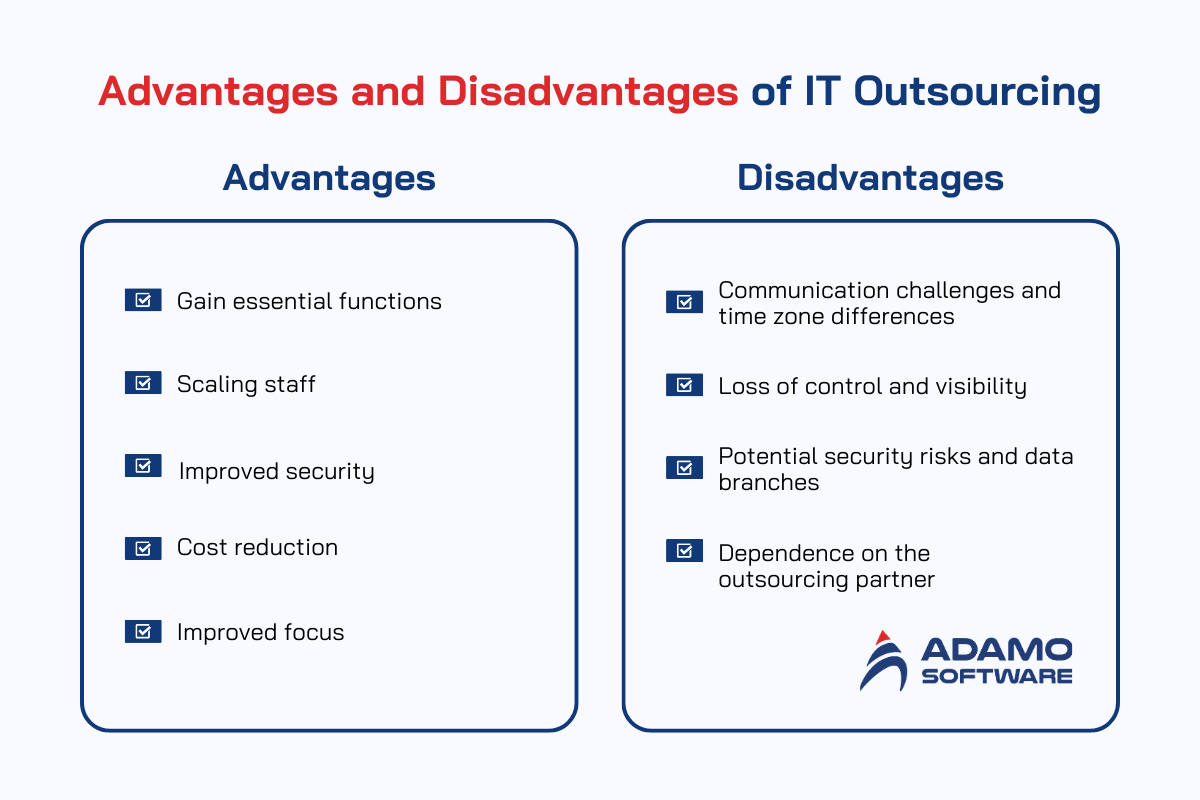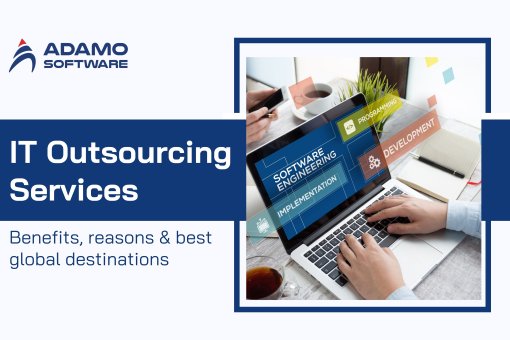
IT outsourcing is a valuable solution for businesses. By hiring temporary professionals, IT outsourcing helps companies save costs, bringing greater competitive advantage. However, using this model for specific business needs can present some challenges.
This article will discuss the definition of IT Outsourcing, its typical types of IT outsourcing models, pricing, and where best to outsource your IT functions.
I. What Is IT Outsourcing
In simple words, IT outsourcing refers to the process a business delegates specific operations, functions, or services to a third party.
This approach can enable enterprises to reduce costs and has many benefits for businesses, especially startup founders. IT outsourcing can be a valuable solution to propelling their business forward faster and saving more money than they could with a small in-house team.
II. Outsourcing vs. In-House Team: Key Differences
1. Recruitment and training:
– In-House Team: Have trouble in hiring hassles, namely interviewing, screening, and training in-house IT teams.
– Outsourcing: Services are outsourced by a reliable company in the market or a competent competent offshore software development company.
2. Labor cost and time
– In-House Team: Time and cost investment on recruitment, infrastructure, setup, tax, salaries, and retention.
– Outsourcing: Less commitment in the long run. Provides flexibility with lower initial expenses.
3. Access to expertise
– In-House Team: Restrict access to a diverse talent pool and highly qualified individuals.
– Outsourcing: Access to global talents that have knowledge, skills, experience, technologies and tools.
4. Risk management
– In-House Team: Bears all project risks, including delays, quality issues, and technology changes.
– Outsourcing: Share project risks with the service provider.
5. Focus on core business
– In-House Team: Requires significant management attention and resources to oversee the in-house IT teams.
– Outsourcing: Concentrate more on core business operations.
Also read: Offshore IT Outsourcing: What Is It, Pros & Cons, Top Destinations
III. Advantages and Disadvantages of IT Outsourcing

Advantages of IT Outsourcing
There are plenty of benefits of IT Outsourcing for both small businesses and huge enterprises.
1. Gain Essential Functions
IT outsourcing can help your business gain essential functions. Third-party providers have options for essential services such as data storage or security monitoring.
If you want to use virtualized software but face capital constraints, IT outsourcing can be the solution. Depending on the provider, it allows you to integrate these vital services into your infrastructure.
2. Scaling Staff
Scaling on new staff, especially with IT can create challenges and difficulties in terms of time and cost.
But there’s a valuable solution. With outsourcing, you have the flexibility to scale your team up or down based on project demands. When projects finish, you can also reduce staff numbers.
This flexibility provides exceptional control over project management, saving both time and cost to hire and train new employees.
3. Improved Security
IT Outsourcing allows a business to access additional security solutions, including data monitoring, protection, and backup for improved security.
Providers can monitor and flag unusual network activity, ensure essential software like anti-virus, and adhere to the best cybersecurity practices.
This is important for businesses that lack the capital to invest in robust cybersecurity infrastructure, which can leave dangerous gaps in coverage.
Solving these gaps prevents potential intrusions and a host of other problems. IT outsourcing services will help enhance your security.
4. Cost Reduction
IT outsourcing offers cost reduction benefits. Help businesses reduce capital required to train or keep long-term staff.
Additionally, Managed Service Providers (MSPs) can provide IT infrastructure through virtualized services. Instead of an enterprise needing to establish infrastructure itself.
To sum up, these advantages positively, along with numerous indirect benefits such as improved efficiency and better security, impact a company’s bottom line and help it remain competitive with IT, even without resources available locally.
5. Improved Focus
Outsourcing IT doesn’t a business lacks in-house IT capabilities. Often, businesses outsource to patch up weaker areas of the organization or assist with larger projects.
This strategy enables on-site staff to concentrate on their specialties and prioritize goals. For example, outsourcing IT to manage customer inquiries while the in-house team can focus on critical tasks such as cybersecurity monitoring, network enhancements, and new infrastructure installations.
By leveraging IT outsourcing, organizations can optimize their resources and improve overall efficiency.
Disadvantages of IT outsourcing
While IT outsourcing can be a valuable solution to save money and improve efficiency for business, it’s important to be aware of its downside.
Let’s discuss some of the main drawbacks of IT outsourcing
1. Communication Challenges & Time Zone Differences
Communication is a very important element of an IT project. Therefore, significant time zone differences and communication can cause loss that companies.
Collaboration can be affected by language barriers and differences in location and culture. To improve this issue, both sides have to choose a time when both parties can contribute to work hours.
Language difference is a big challenge. However, you can avoid such problems by learning a foreign language or making sure that the external partner speaks the same language as you do
2. Loss of Control & Visibility
The cons of IT outsourcing can relieve your team but also means losing some control over business processes.
Outsourced employees manage functions and processes, including IT services, customer support, and manufacturing. Their timelines, procedures, and systems are beyond your direct control, potentially affecting service quality and standards.
To prevent this, it’s important to maintain consistent communication and guide outsourced teams toward your business objectives. Ensuring that they understand your request and keep you informed of any changes, creates better visibility and control over their actions.
3. Potential Security Risks & Data Breaches
One significant drawback of IT outsourcing is the risk of data breaches and security risks. It can expose your business to the potential leakage of important data, including the private information of clients.
You can avoid such problems by establishing an impassable outsourcing contract to protect your information. Ensuring every detail from the contract is implemented and highlights the repercussions of misuse regarding your company’s data.
Additionally, having both parties sign non-disclosure agreements (NDAs) helps safeguard your data and prevent security breaches.
4. Dependence on the Outsourcing Partner
One of the disadvantages of IT Outsourcing is an overreliance on the outsourced partner. That could result in financial troubles and changes in ownership. This approach even causes the failure of business.
It is important to mitigate any risks and develop contingency plans to prevent any errors that could occur if outsourced employees terminate their contracts.
5. Impact on Employee Morale
Another notable drawback of IT outsourcing is losing employee morale for your in-house team and reducing productivity.
Effective outsourcing may result in the termination of certain roles, causing anxiety among your team and affecting their growth and trust in the company.
Additionally, outsourced IT can hardly keep up with the training program required. This could lead to hinder progress and an increase in funds spent.
Also read: IT Outsourcing Services: Benefits, reasons & best global destinations
IV. Different Types of IT Outsourcing
There are 3 types of IT outsourcing:
1. Onshore
Refers to outsourcing your software development to a company located in the same country or region. For instance, your team is based in Hanoi, while additional resources are outsourced from a company in Ho Chi Minh City. It’s the most convenient option to keep everything under control at a save cost.
2. Nearshore Outsourcing
Outsourcing to neighboring countries with the same time zone. For instance, if you are based in Vietnam, you might consider hiring a team from Thailand, Laos, Cambodia, and Indonesia. By choosing this type, it’s easier for you to communicate with a partner, this option isn’t always profitable.
3. Offshore
It is outsourcing with a company located in a different country, even on the opposite side of the globe, with a distinct time zone. By approaching this type, you can save up the most.
V. IT Outsourcing Models
There are 3 common types of IT outsourcing models:

1. Project-Based Model
– How it works: The client hires a team to implement a part of the work that is already planned. The outsourced project manager takes full responsibility for project quality and performance.
– When to use: The project-based IT outsourcing model is suitable for basic projects with well-defined requirements and predictable functionality.
2. Dedicated Team Model
– How it works: The business hires an IT team that will create a project for them, and they will work only on that project. Unlike the project-based model, this approach involves deeper engagement. In this dedicated team model, an IT outsourced team becomes your technical and project advisor.
– When to use: The dedicated team IT outsourcing model is best for early-stage startups aiming to scale, long-term complex projects. It’s beneficial for validating ideas, finding product-market fit, or developing an MVP.
3. Outstaff Model
– How it works: This model involves hiring separate specialists rather than a full-fledged development team. When you need some additional professionals for short-term projects, you’re free to hire staff workers to cover that scope of work.
– When to use: The outstaff IT outsourcing model is the best suited to short-term projects or businesses that need extra specific knowledge hands to scale their business fast.
VI. IT Outsourcing Pricing Models
As a business owner, selecting the right pricing model is crucial for meeting your organization’s needs. Let’s delve into the primary IT outsourcing pricing structures to help you make an informed decision.

1. Fixed price model
In this fixed price model, clients agree to a set price for the entire project, regardless of the duration it takes to complete. This approach is advantageous for the service provider and allows them to forecast project revenue accurately.
Clients prefer this pricing model because it assures them a fixed price for the services provided.
2. Time and materials (T&M) model
In this dedicated team pricing, the client pays every month for the work based on the agreed rate for the dedicated team. This model is similar to the managed team model in terms of cooperation. However, the hourly rates are usually lower than for the time and materials model.
This model is advantageous as it ensures they only pay for the actual services used.
3. Dedicated Team Pricing
In this dedicated team pricing, the client pays every month for the work based on the agreed rate for the dedicated team. This model is similar to the managed team model in terms of cooperation. The hourly rate is generally lower than for the time and materials model.
VII. When to Choose IT Outsourcing
According to Deloitte, 70% of businesses choose IT outsourcing primarily for its cost-effectiveness, with flexibility being a key factor for 40% of them.
IT outsourcing services are a good fit if you:
– Lack of In-House Talent: When your current team is occupied with existing projects or lacks the specific IT skills required for software project planning and delivery.
– Tight Deadlines: Meeting critical project timelines is crucial for success. IT outsourcing services are the best solution for delivering projects on time.
– Specialized Roles: Projects with unique technical requirements necessitate developers with specialized expertise, readily available through IT outsourcing.
– Complex Projects: Projects requiring deep technical knowledge and industry experience benefit from the expertise of offshore agencies’ seasoned professionals.
– Cost Efficiency: Outsourcing software development helps reduce costs compared to maintaining an in-house team, without compromising on quality.
VIII. Estimated Cost of IT Outsourcing
The cost of IT outsourcing is based on several critical factors, primarily the hourly rates of developers and the scale of the project team involved.
It’s important to distinguish between IT outsourcing and IT outstaffing. IT outsourcing involves delegating an entire project to an external company, whereas outstaffing allows you to hire remote developers who function as part of your in-house team.
For IT outsourcing projects, costs typically range from $50,000 to $250,000. Conversely, in IT outstaffing arrangements, where individual developers are hired, prices can vary widely. On average, rates for a single developer range from $25 to $100 per hour, depending on their expertise and geographic location.
IX. How to Choose the Best IT Outsourcing Partner
Finding the best IT Outsourcing partner can greatly enhance your business’s growth. You can follow these simple steps for your choose process:
– Set up a Budget: First, you need to set up a budget for an IT outsourcing project, including a plan for both short-term and long-term costs, initial set-up fees, regular maintenance, and possible expansion expenses. A clear budget will help you optimize your options. That has the expertise you need. Check expertise, experience, and client testimonials. You can also check if they have handled similar projects before or work with companies like yours.
– Consider Communication & Time Zone: In collaboration, efficient communication is vital during outsourcing. Choose a company with whom you would be able to communicate without any language barriers and ensure that there are the same working hours so that work be taken place better.
– Data Security and Privacy: Protection must be ensured by all means. Its security features are robust enough including data encryption standards, access controls plus adherence to data protection directives.
– Plan for the long-term: The partnership should have potential to grow over time and support the long-term success of your business.
X. 5 Best Countries for IT Outsourcing

1. Vietnam
Vietnam is considered the next “Silicon Valley” of Southeast Asia in recent years. The IT outsourcing sector in Vietnam has been growing at an impressive annual rate of 13.31% and is projected to reach $881.90M by 2027.
Skill: In recent years, Vietnam has been very strong in AI and ranked 3rd in AI competency according to Hacker Rank 2016. Furthermore, according to US news, Vietnam is one of the top countries for web development outsourcing.
Communication: English skills of Vietnamese engineers rank 66/112 countries in the EF English Proficiency Index (2021).
Time zone: GMT+7
Cost: $18–$40 per hour
2. India
India has long been recognized as one of the best IT outsourcing destinations in the world.
Skill: India boasts an employment rate of 93.5% for software engineers and its revenue market is projected to reach USD 7.72 billion in 2024. Its IT outsourcing service offers cutting-edge telecom, cellular network, and ISPs.
Communication: India is the world’s second-largest English-speaking country. Businesses around the world do not need to worry about miscommunication and language barrier. However, Indian English has a strong local accent, which can be difficult and pose a hindrance to communication.
Time zone: GMT+5:30
Cost: $19 – $45 per hour
3. Poland
In Eastern Europe, Poland is one of the best IT outsourcing countries in the world. The country is known to comply with data protection and cybersecurity regulations and own highly qualified specialists.
Skill: The most popular software languages in this country are Java, PHP, Python, Ruby, and Shell, and outsourced services recorded are IT services, web development, and PHP programming outsourcing.
Communication: In Poland, about 90% population is fluent in English.
Time zone: GMT+1
Cost: $25–$50 per hour
4. Brazil
Brazil is in the top #13 on the top software outsourcing countries worldwide and the leader among the top IT Outsourcing Countries in Latin America.
Skill: Brazil has more than 500,000 IT professionals. Most Brazilian IT are proficient in programming languages like C++, Java, JavaScript, Python, and Perl. According to Clutch, the top IT outsourcing services provided by Brazilian are Web Development and Mobile App Development.
Communication: Software developers in Brazil are good at English, making it simple for businesses to collaborate with Brazilian developers.
Time-zone: GMT-3
Cost $25 to $80 per hour
5. China
China is the top Asian IT outsourcing countries. The IT outsourcing market in China is growing by about 30% every year.
Skill: China’s top software outsourcing projects involve data structure, Python, Shell, and functional programming. This country has several tech hubs and is home to many tech firms, making it perfect for IT outsourcing needs.
Communication: Chinese people have low English communication skills. This poses an inevitable barrier to communication for English-speaking clients.
Time zone: GMT+8
Cost: $22–$45 per hour
XI. Why Choose Adamo as A Trustworthy Vendor for IT Outsourcing
Adamo Software is a leading software development company in Vietnam, that offers comprehensive services including mobile app development, web solutions, AI development, and blockchain services. Our dedicated developers deliver high-quality, cost-effective software solutions with a fast time to market.

We provide flexible IT outsourcing models to serve SMEs and multinational corporations, leveraging the latest IT technologies to bring your business ideas to life.
If you’re interested in our services IT outsourcing, seeking advice, or getting more information about Adamo Software, please feel free to contact us.











